SailPoint Bundle
Who Really Controls SailPoint Technologies?
In the ever-evolving cybersecurity realm, understanding the ownership structure of key players is paramount. SailPoint, a leader in enterprise identity security, recently made headlines with its re-entry into the public market via IPO in February 2025. This move prompts critical questions about who truly steers the ship and what it means for investors and the future of identity governance.
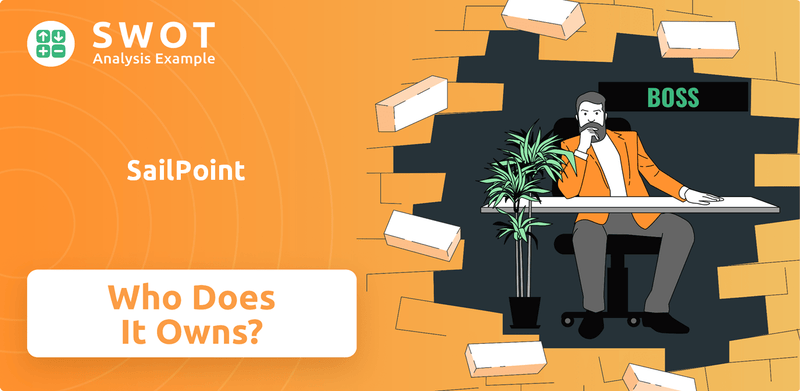
SailPoint's journey, from its founding in 2005 by Mark McClain, Kevin Cunningham, and Jackie Gilbert, to its current status as a publicly traded company, is a story of strategic shifts and significant investment. This exploration will uncover the key players behind SailPoint SWOT Analysis, examining the influence of major investors and the dynamics shaping the company's future. Understanding the SailPoint ownership structure is crucial for anyone seeking to navigate the complexities of the identity security market, including its financial performance and the role of the SailPoint parent company.
Who Founded SailPoint?
SailPoint Technologies was established in 2005. The company's origins trace back to Austin, Texas, with a core team of entrepreneurs. Their combined expertise in identity management laid the foundation for SailPoint's early success.
The founders, Mark McClain, Kevin Cunningham, and Jackie Gilbert, brought significant experience to the table. McClain, serving as CEO, and Cunningham had previously co-founded Waveset, which Sun Microsystems acquired. Gilbert's background in identity management further strengthened the team.
Early financial backing from venture capital firms fueled SailPoint's growth. This early investment supported the development and launch of IdentityIQ, their initial identity governance platform.
Mark McClain, Kevin Cunningham, and Jackie Gilbert founded SailPoint in 2005.
Series B funding of $10 million was announced in January 2007.
IdentityIQ, an identity governance platform, was launched in 2007.
Lightspeed Venture Partners, Austin Ventures, Origin Partners, and Silverton Partners were key investors.
Mark McClain served as the CEO and Founder of SailPoint.
The company focused on addressing the need for identity compliance.
The founders' vision centered on identity governance, leveraging their prior experience. Early investments provided the capital to develop their initial product, IdentityIQ. SailPoint's focus on identity governance solutions was a direct result of the founders' expertise in the identity management market. The company's early strategy was to establish a strong foothold in the identity security platform market.
- The initial funding rounds were crucial for product development.
- The founders' experience shaped the company's core offerings.
- SailPoint's early focus was on identity governance.
- Early investors played a key role in the company's growth.
SailPoint SWOT Analysis
- Complete SWOT Breakdown
- Fully Customizable
- Editable in Excel & Word
- Professional Formatting
- Investor-Ready Format
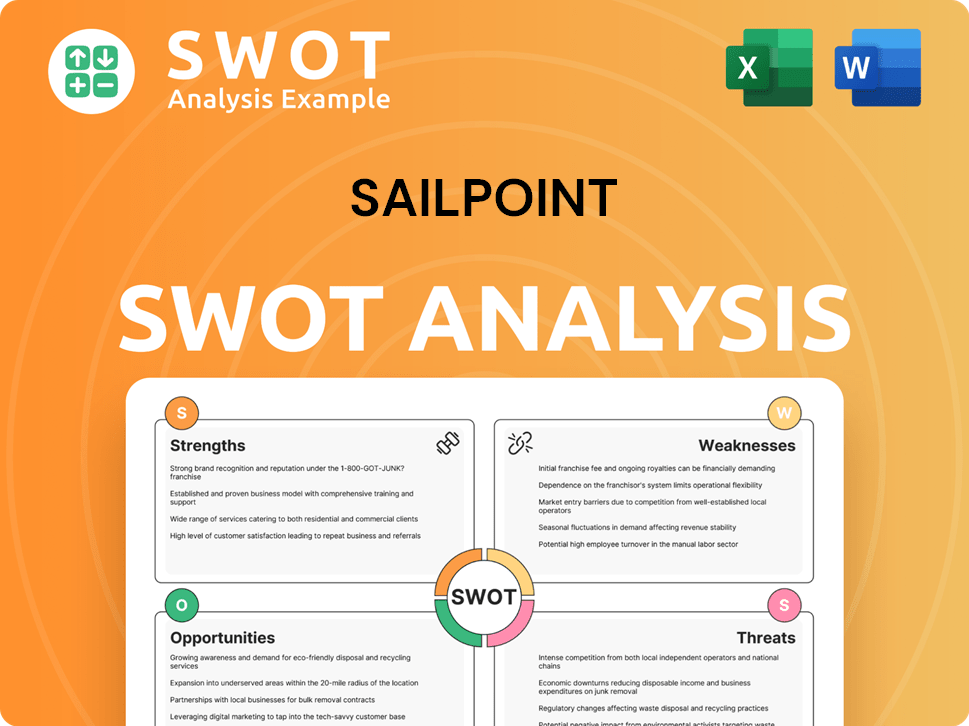
How Has SailPoint’s Ownership Changed Over Time?
The ownership structure of SailPoint has seen significant shifts since its inception. Initially, the company went public in November 2017, trading on the New York Stock Exchange under the ticker 'SAIL'. However, this public phase was short-lived. In April 2022, Thoma Bravo, a software investment firm, agreed to acquire SailPoint in an all-cash deal valued at approximately $6.9 billion. This acquisition was finalized on August 16, 2022, with stockholders receiving $65.25 per share, leading to the company becoming privately held and delisted from the NYSE. This marked Thoma Bravo's second acquisition of SailPoint, having previously acquired the company in 2014 before its initial IPO in 2017.
As of February 12, 2025, SailPoint, formerly SailPoint Parent, LP, transitioned into a Delaware corporation named SailPoint, Inc., in connection with its second initial public offering. The company priced its upsized IPO at $23.00 per share, offering 60 million shares and raising $1.38 billion, with a total valuation of $12.8 billion. Despite returning to the public market, Thoma Bravo remains a major stakeholder, retaining a 76% stake post-IPO, maintaining significant control. This allows SailPoint to leverage Thoma Bravo's operational expertise, financial support, and software knowledge to accelerate innovation and expand its global customer base. Institutional investors like AllianceBernstein and Dragoneer Investment Group committed to purchasing up to 20% of the IPO shares, indicating confidence in SailPoint's growth.
| Event | Date | Impact on Ownership |
|---|---|---|
| Initial Public Offering (IPO) | November 2017 | Company became publicly traded on the NYSE. |
| Acquisition by Thoma Bravo | August 16, 2022 | SailPoint became privately held; delisted from NYSE. |
| Second Initial Public Offering (IPO) | February 12, 2025 | SailPoint returned to public market; Thoma Bravo retained a significant stake. |
Thoma Bravo's continued significant ownership highlights its long-term commitment and strategic vision for SailPoint, ensuring the company benefits from its resources and expertise. The recent IPO demonstrates a strategic move to capitalize on market opportunities while maintaining a strong foundation for future growth. For further insights into the competitive environment, consider exploring the Competitors Landscape of SailPoint.
SailPoint's ownership has evolved from public to private and back to public, with Thoma Bravo as a major player.
- Thoma Bravo acquired SailPoint in 2022 and again in 2014.
- The recent IPO in February 2025 saw Thoma Bravo retain a 76% stake.
- Institutional investors show confidence in SailPoint's future.
- The company is now focused on expanding its identity governance solutions.
SailPoint PESTLE Analysis
- Covers All 6 PESTLE Categories
- No Research Needed – Save Hours of Work
- Built by Experts, Trusted by Consultants
- Instant Download, Ready to Use
- 100% Editable, Fully Customizable
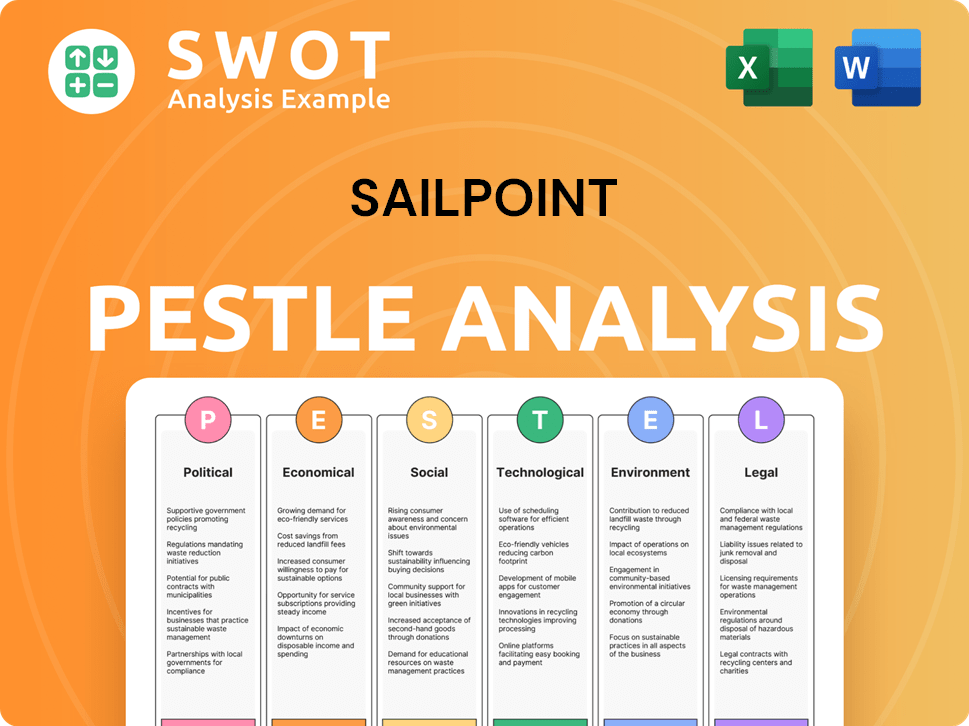
Who Sits on SailPoint’s Board?
While specific details on the current individual board members and their affiliations with major shareholders or independent seats are not extensively detailed in the provided search results from 2024-2025, it is clear that SailPoint's board and voting structure are significantly influenced by its ownership evolution, particularly the substantial stake held by Thoma Bravo. As of its recent IPO in February 2025, Thoma Bravo retained a 76% stake in SailPoint, effectively ensuring its continued control over the company.
The executive team, which typically includes key leadership roles such as CEO, President, CFO, and CTO, plays a crucial role in the day-to-day operations and strategic execution under the board's guidance. Mark McClain remains the CEO and Founder, with other key executives including Matt Mills (President), Abby Payne (Chief People Officer), Brian Carolan (Chief Financial Officer), and Chandra Gnanasambandam (EVP Product and CTO).
| Executive | Title | |
|---|---|---|
| Mark McClain | CEO and Founder | |
| Matt Mills | President | |
| Brian Carolan | Chief Financial Officer |
In general, for publicly traded companies, the voting structure typically operates on a one-share-one-vote basis, meaning each share of common stock grants one vote. In the context of SailPoint's acquisition by Thoma Bravo in 2022, and its subsequent re-IPO, the private equity firm's majority ownership implies a direct and significant impact on voting power for major decisions. When SailPoint was taken private in 2022, stockholders voted to approve the acquisition, with each share of common stock entitling its holder to one vote. While SailPoint has returned to being a public company, Thoma Bravo's retained 76% ownership means they hold the majority of voting power, allowing them to elect a majority of the board of directors and influence strategic decisions. This arrangement is common when a private equity firm takes a company private and then re-lists it, maintaining significant control to implement their long-term growth and profitability strategies.
SailPoint's ownership structure is heavily influenced by Thoma Bravo, which holds a significant majority stake. This impacts the company's board composition and strategic direction. The voting power is largely controlled by Thoma Bravo, which can elect the majority of the board.
- Thoma Bravo's 76% ownership ensures control.
- The board of directors oversees strategic decisions.
- Mark McClain remains the CEO and Founder.
- The company's history includes a 2022 acquisition and subsequent re-IPO.
SailPoint Business Model Canvas
- Complete 9-Block Business Model Canvas
- Effortlessly Communicate Your Business Strategy
- Investor-Ready BMC Format
- 100% Editable and Customizable
- Clear and Structured Layout
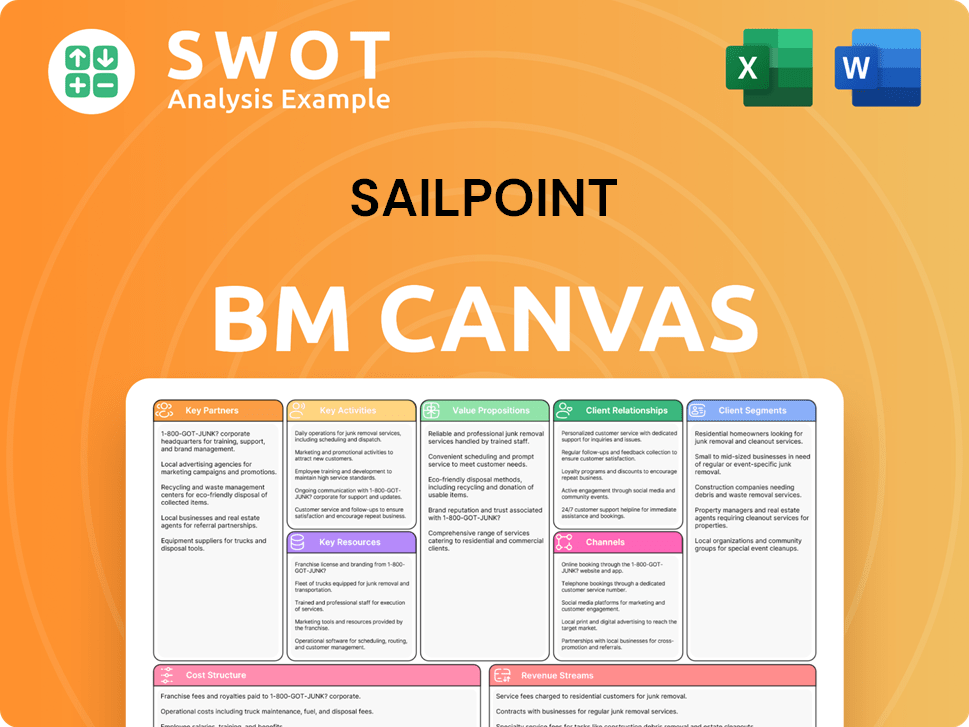
What Recent Changes Have Shaped SailPoint’s Ownership Landscape?
The recent ownership landscape of SailPoint has been marked by significant shifts over the past few years. Initially a publicly traded entity, the company transitioned to private ownership under Thoma Bravo in August 2022 following a $6.9 billion acquisition announced in April 2022. This move allowed SailPoint to leverage Thoma Bravo's expertise and financial backing, which helped accelerate its growth and SaaS transformation.
A key development is SailPoint's renewed presence in the public market. In February 2025, the company conducted its second IPO, with shares priced at $23.00 each. This IPO, which raised $1.38 billion through the offering of 60 million shares, valued the company at approximately $12.8 billion. Despite this return to the public market, Thoma Bravo maintains a substantial stake, holding a significant 76% ownership of SailPoint. This allows Thoma Bravo to continue influencing SailPoint's strategic direction, including future acquisitions.
| Metric | Value | Date |
|---|---|---|
| Annual Recurring Revenue (ARR) | $877 million | January 31, 2025 |
| SaaS ARR | $540 million | January 31, 2025 |
| Total Revenue (Fiscal Year 2024) | $861.61 million | Fiscal Year 2024 |
| Total Revenue (Forecast FY2026) | $1,025 million - $1,035 million | Fiscal Year 2026 |
SailPoint's recent acquisitions, particularly under Thoma Bravo's ownership, highlight its focus on expanding its identity security platform. These acquisitions include Imprivata's IGA business (December 2024), Double Zero (April 2024), Osirium (October 2023), and SecZetta (January 2023). These strategic moves enhance SailPoint's capabilities in areas like privileged access management and identity threat detection. For an in-depth look at the company's strategic growth, consider reading about the Growth Strategy of SailPoint.
The recent IPO in February 2025 raised $1.38 billion and valued the company at approximately $12.8 billion. The IPO was oversubscribed by 20x, indicating strong investor interest.
Despite the IPO, Thoma Bravo retains a significant 76% ownership stake in SailPoint. This allows Thoma Bravo to continue influencing SailPoint's strategy and acquisitions.
SailPoint's ARR reached $877 million and SaaS ARR reached $540 million as of January 31, 2025. Total revenue for fiscal year 2024 was $861.61 million, up 23.16% year-over-year.
For fiscal year 2026, SailPoint forecasts total ARR in the range of $1,075 million to $1,085 million and total revenue between $1,025 million and $1,035 million.
SailPoint Porter's Five Forces Analysis
- Covers All 5 Competitive Forces in Detail
- Structured for Consultants, Students, and Founders
- 100% Editable in Microsoft Word & Excel
- Instant Digital Download – Use Immediately
- Compatible with Mac & PC – Fully Unlocked
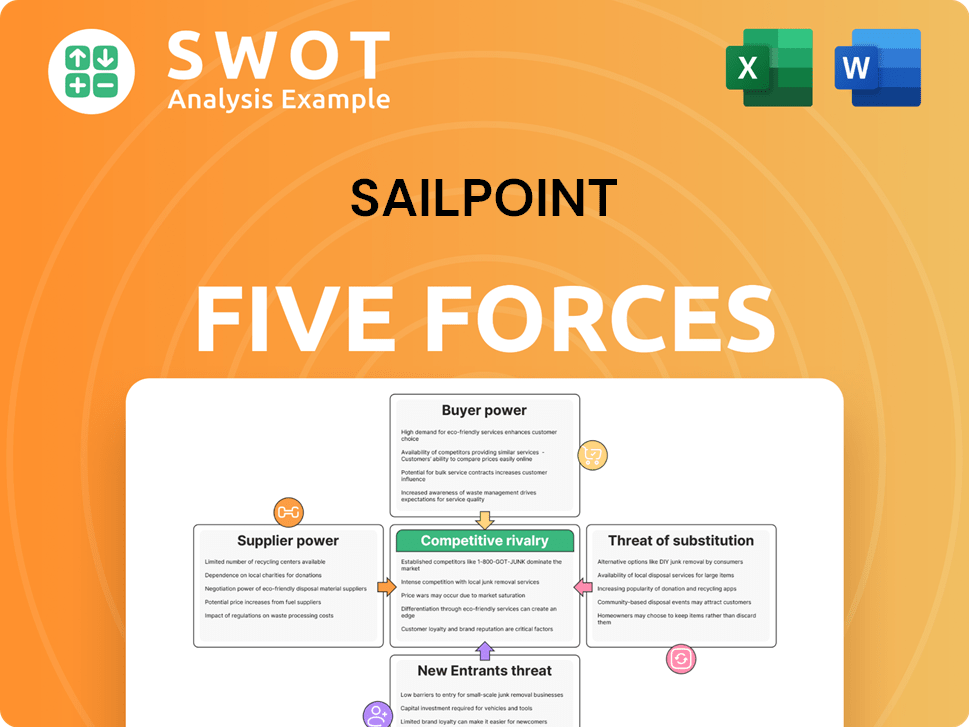
Related Blogs
- What are Mission Vision & Core Values of SailPoint Company?
- What is Competitive Landscape of SailPoint Company?
- What is Growth Strategy and Future Prospects of SailPoint Company?
- How Does SailPoint Company Work?
- What is Sales and Marketing Strategy of SailPoint Company?
- What is Brief History of SailPoint Company?
- What is Customer Demographics and Target Market of SailPoint Company?
Disclaimer
All information, articles, and product details provided on this website are for general informational and educational purposes only. We do not claim any ownership over, nor do we intend to infringe upon, any trademarks, copyrights, logos, brand names, or other intellectual property mentioned or depicted on this site. Such intellectual property remains the property of its respective owners, and any references here are made solely for identification or informational purposes, without implying any affiliation, endorsement, or partnership.
We make no representations or warranties, express or implied, regarding the accuracy, completeness, or suitability of any content or products presented. Nothing on this website should be construed as legal, tax, investment, financial, medical, or other professional advice. In addition, no part of this site—including articles or product references—constitutes a solicitation, recommendation, endorsement, advertisement, or offer to buy or sell any securities, franchises, or other financial instruments, particularly in jurisdictions where such activity would be unlawful.
All content is of a general nature and may not address the specific circumstances of any individual or entity. It is not a substitute for professional advice or services. Any actions you take based on the information provided here are strictly at your own risk. You accept full responsibility for any decisions or outcomes arising from your use of this website and agree to release us from any liability in connection with your use of, or reliance upon, the content or products found herein.